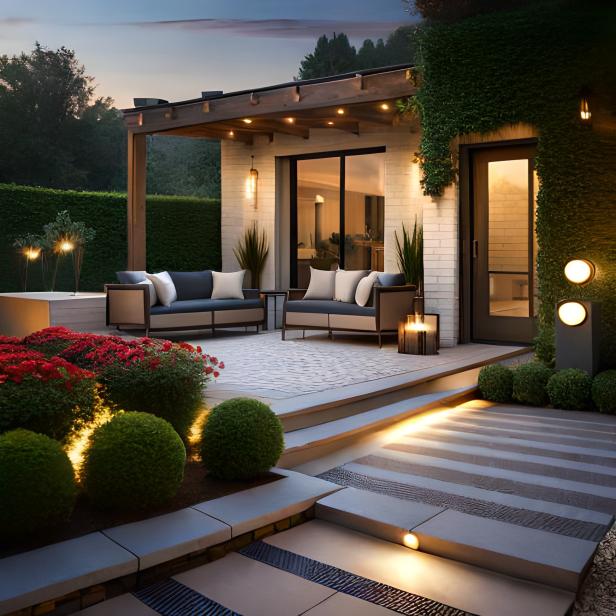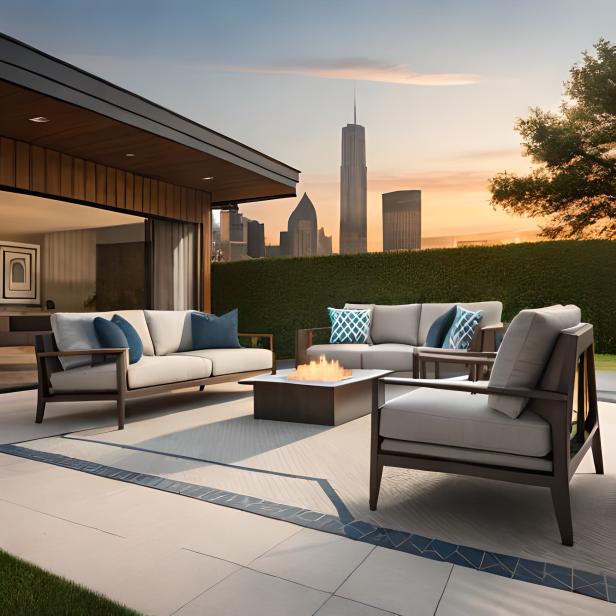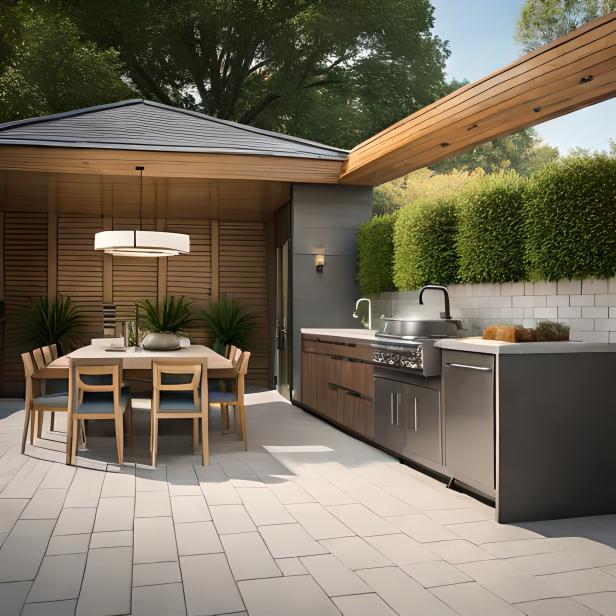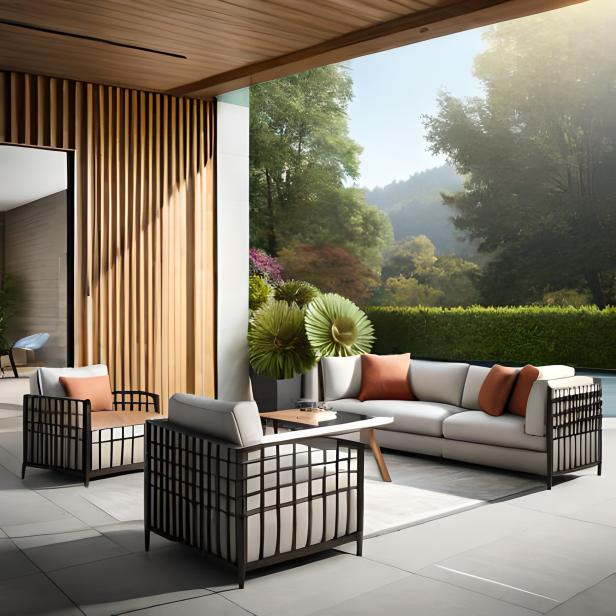Enhance your outdoor living experience by using pavers to explore creative and functional patio extension ideas. Through the power of infographics, this comprehensive guide will provide expert tips, design inspiration, and practical advice for homeowners looking to expand their outdoor space.
Choosing the Right Type of Paver
Choosing the correct type of paver for your patio extension is an important decision that can significantly impact your outdoor space’s overall look and feel. To make an informed choice, it’s essential to consider various factors such as cost, aesthetics, and maintenance requirements. Let’s look at the three most popular paver materials: concrete, brick, and natural stone.
Concrete Pavers: Concrete pavers are known for their durability and versatility. They are available in various colors, shapes, and sizes, making it easy to find a style that suits your taste and complements your existing outdoor decor. Concrete pavers are relatively affordable, especially when compared to natural stone. They are also easy to install and withstand heavy foot traffic and harsh weather conditions. However, over time, the color of concrete pavers may fade slightly, and they may require occasional cleaning and sealing to maintain their appearance.
Brick Pavers: Brick pavers have a timeless appeal that adds a classic and elegant touch to any patio. They are available in various shades of red and brown, allowing you to create a warm and inviting outdoor space. Brick pavers are renowned for their strength and durability, and they can last for decades when properly maintained. They are resistant to fading and are relatively low-maintenance. However, it’s worth noting that brick pavers can be more expensive than concrete pavers. Additionally, they may be more challenging to install due to their uniform size and shape.
Natural Stone Pavers: Natural stone pavers exude luxury and natural beauty. They are available in various materials, such as granite, limestone, sandstone, and travertine, each with unique colors and textures. Natural stone pavers offer a high-end aesthetic and can instantly elevate the look of your patio. They are incredibly durable and can withstand heavy use and extreme weather conditions. Maintenance requirements for natural stone pavers can vary depending on the type of stone chosen. Some stones may require periodic sealing to protect against stains and moisture absorption. However, it’s important to note that natural stone pavers are generally the most expensive option.
In conclusion, selecting the correct type of paver for your patio extension involves considering cost, aesthetics, and maintenance requirements. Concrete pavers offer affordability and versatility, brick pavers provide a classic and timeless appeal, while natural stone pavers offer a luxurious and unique look. You can choose the perfect paver material to enhance your outdoor space for years by carefully weighing your options and considering your preferences.
Popular Patio Extension Designs
Regarding patio extension designs, there are numerous options to explore and unleash your creativity. The infographic above showcases popular methods to transform your outdoor space into a stunning and inviting area. Let’s take a closer look at each design:
1. Herringbone Pattern: The herringbone pattern is a classic choice that adds a touch of elegance and sophistication to your patio. It involves laying rectangular pavers in a diagonal pattern, creating a zigzag effect. This design offers a visually exciting look that complements traditional and modern styles.
2. Running Bond Pattern: The running bond pattern is versatile and widely used. It involves laying pavers in a staggered pattern, each row offset by half a paver’s length. This creates a clean and orderly appearance, making it a popular choice for various architectural styles.
3. Basketweave Pattern: The basketweave pattern is a visually appealing option that adds texture and intricacy to your patio. It involves alternating sets of rectangular pavers, creating a woven or basket-like effect. This design can bring a unique charm to your outdoor space and works well with contemporary and rustic aesthetics.
4. Circular Pattern: The circular pattern is dynamic and eye-catching, adding a focal point to your patio. It involves arranging pavers in a circular or curved shape, creating a visually pleasing and flowing effect. This design is perfect for making cozy seating areas or accentuating the center of your outdoor space.
Mixing Shapes, Colors, and Textures: To create a truly unique and visually appealing patio extension, consider mixing different shapes, colors, and textures of pavers. Combining square, rectangular, and circular pavers in complementary or contrasting colors can add depth and visual interest to your outdoor space. Introducing varied textures like smooth and textured surfaces can further enhance the overall design aesthetic.
Remember, the design possibilities for your patio extension are virtually limitless. Feel free to experiment with different patterns, materials, and layouts to create a personalized outdoor oasis that reflects your style and preferences. Whether you choose a classic herringbone pattern, a versatile running bond design, an intricate basketweave layout, or an attention-grabbing circular arrangement, let your imagination guide you in creating a patio that will be enjoyed for years.

DIY vs. Professional Installation
Regarding a patio extension project, you might be debating between tackling it as a do-it-yourself (DIY) project or hiring a professional to handle the installation. It’s an important decision that can significantly impact the outcome of your project. To help you make an informed choice, let’s explore the benefits and drawbacks of each approach, as outlined in the infographic above.
DIY Installation:
Benefits:
- Cost Savings: One of the primary advantages of a DIY installation is the potential for cost savings. By taking on the project yourself, you can avoid the labor costs of hiring a professional.
- Sense of Accomplishment: Completing a patio extension as a DIY project can bring a sense of fulfillment and pride. It allows you to take ownership of the project and witness the transformation of your outdoor space firsthand.
- Flexibility and Control: With a DIY installation, you can choose the materials, design, and timeline that suit your preferences. You have complete control over every aspect of the project.
Drawbacks:
- Time and Effort: Undertaking a patio extension as a DIY project requires significant time and effort. You must dedicate your resources to ensure a successful outcome from planning and preparation to the installation.
- Skill and Expertise: Patio installation may require specific skills and knowledge. If you’re not experienced in this type of work, a learning curve may be involved, and mistakes could lead to additional costs or a less-than-desirable result.
- Limited Warranty: Remember that DIY installations may not have warranties or guarantees typically provided by professional contractors. This means you’ll be responsible for any issues or repairs that arise in the future.
Professional Installation:
Benefits:
- Expertise and Experience: Hiring a professional ensures that your patio extension is handled by experts with the necessary skills and experience to deliver high-quality results. They are well-versed in proper installation techniques, ensuring durability and longevity.
- Time Efficiency: Professionals have the knowledge and tools to complete the installation efficiently. They can work within a set timeline, minimizing disruptions to your daily routine.
- Warranty and Support: Reputable professionals often provide warranties for their work. This can offer peace of mind knowing that if any issues arise, they will be addressed without additional costs on your part.
Drawbacks:
- Cost Considerations: Hiring a professional for your patio extension will involve additional costs beyond the materials. Labor fees can vary depending on the complexity of the project and the region you’re in.
- Less Control over Design: Professionals can offer guidance and expertise, but you may have less control over the design process than a DIY project. You’ll need to communicate your preferences clearly and ensure they align with the contractor’s capabilities.
- Scheduling Challenges: Depending on contractors’ availability, some scheduling challenges may be involved. Popular contractors might have a backlog of projects, which could result in longer wait times for your installation.
In conclusion, deciding between a DIY installation and hiring a professional for your patio extension involves considering cost, time, skill level, and desired level of control. If you have the necessary skills, time, and willingness to take on the project yourself, a DIY installation can be a rewarding experience. However, hiring a contractor can ensure a smoother and more efficient process if you prefer to rely on the expertise of professionals or if the project requires specialized knowledge. Assess your budget, timeline, and comfort level before deciding to ensure that you choose the approach that best suits your needs and preferences.
Patio Extension Costs
When planning a patio extension project, it’s essential to understand the costs involved clearly. The infographic above provides valuable insights into the factors that can impact the overall price, such as the type of paver, project size, and labor costs. While costs vary depending on various factors, you can generally expect to spend between $10 and $25 per square foot for materials and installation. Let’s delve into these cost considerations in more detail:
1. Paver Type: The type of paver you choose for your patio extension can significantly impact the overall cost. Concrete pavers are typically more affordable, ranging from $3 to $7 per square foot. Brick pavers can cost slightly more, ranging from $8 to $12 per square foot. Natural stone pavers are generally the most expensive option, ranging from $15 to $30 per square foot or more, depending on the type of stone chosen.
2. Project Size: The size of your patio extension project directly affects the total cost. The larger the area, the more materials and labor required, resulting in higher costs. Remember that the price per square foot may decrease as the project size increases due to economies of scale. Conversely, smaller projects may have a slightly higher price per square foot.
3. Labor Costs: Labor costs are a significant component of the overall price for a patio extension. The complexity of the project, accessibility of the site, and regional labor rates can all influence labor costs. Hiring professionals to handle the installation typically involves additional fees. These costs can vary, but you can expect labor charges to be approximately 30% to 50% of the total project cost.
It’s worth noting that additional factors can also impact the final price, such as site preparation, excavation, and any other features or customization you desire, such as borders, edging, or decorative patterns. These factors should be considered when estimating the total cost of your patio extension project.
To get an accurate estimate for your specific project, it’s advisable to consult with contractors or suppliers who can provide detailed quotes based on your particular requirements. They can assess the project scope, materials, and labor needs to give a more accurate cost estimate tailored to your unique situation.
By considering the type of paver, project size, labor costs, and additional features, you can develop a realistic budget for your patio extension project. Remember to allocate some funds for unexpected expenses or contingencies. With careful planning and budgeting, you can create an outdoor space that enhances your lifestyle and adds value and enjoyment to your home.

Ensuring Proper Drainage
Ensuring proper drainage is an essential consideration for your patio extension project. Without adequate drainage, water accumulation can lead to various issues, such as flooding, erosion, and damage to the pavers. The infographic above provides valuable insights into different drainage solutions that can help you maintain the longevity and functionality of your patio. Let’s explore these solutions in more detail:
1. Sloping: Creating a gentle slope in your patio design effectively encourages water to flow away from the area. By sloping the surface, rainwater and other sources of moisture can naturally drain away, preventing pooling and potential damage. It’s essential to consult with professionals or follow recommended guidelines to ensure the appropriate slope is achieved for efficient drainage.
2. Permeable Pavers: Permeable pavers are designed to allow water to pass through the surface and into the ground below. These pavers are made with materials that have gaps or porous structures, enabling water to infiltrate and drain through the pavement. Permeable pavers can help reduce runoff and mitigate drainage issues, making them an environmentally friendly choice.
3. Drainage Systems: In cases where sloping and permeable pavers alone may not be sufficient, other drainage systems can be implemented. Two standard options are French drains and catch basins:
- French drains involve a trench filled with gravel or rock and a perforated pipe. This system collects and redirects water from the patio area, preventing buildup. French drains are typically installed underground and can be positioned strategically to drain water from the site efficiently.
- Catch basins are structures installed in the patio area to collect excess water. They have a grate or opening that allows water to enter and a pipe system to direct the water away from the patio. Catch basins are especially useful in areas with heavy rainfall or poor soil drainage.
By incorporating these drainage solutions into your patio extension design, you can effectively manage water runoff and prevent water-related issues. Proper drainage protects the integrity of your patio, helps maintain the surrounding landscape, and prevents potential damage to your property.
When planning your patio extension, it’s crucial to assess the existing drainage conditions and consider the topography of your property. Suppose you’re unsure about the best drainage solution for your specific situation. Consulting with professionals or seeking advice from experienced contractors can provide valuable insights and ensure you implement the most appropriate drainage strategy.
By prioritizing proper drainage in your patio extension project, you can enjoy a durable, functional, and beautiful outdoor space for years to come, free from water-related problems that could compromise the integrity of your patio and surrounding areas.
Maintenance Tips for Paver Patios
Regular maintenance is vital to keeping your patio extension looking its best and ensuring its longevity. The infographic above provides valuable maintenance tips that can help you preserve the beauty and functionality of your outdoor space. Following these tips, you can enjoy your patio as an inviting retreat for many years. Let’s explore these maintenance practices in more detail:
1. Cleaning: Regular cleaning is essential to remove dirt, debris, and stains from your paver patio. Use a broom, leaf blower, or pressure washer to remove loose debris. A mild detergent or specially formulated paver cleaner can be used for stubborn stains. Scrubbing with a brush and rinsing with water will help restore the original look of the pavers. Avoid harsh chemicals or high-pressure washing, as these can damage the pavers.
2. Sealing: Applying a sealer to your paver patio can benefit you. Sealing helps protect the pavers from stains, fading, and damage caused by the elements. It also enhances the color and appearance of the pavers. Before sealing, ensure that the pavers are clean and dry. Follow the manufacturer’s instructions for your specific sealer, and reapply as recommended to maintain its effectiveness.
3. Weed Control: Weeds are common in paver patios. Regularly inspect your deck for any weed growth and promptly remove them. Pull out the weeds by hand or use a suitable weed killer, following the instructions and avoiding damaging the surrounding vegetation. Additionally, consider installing a geotextile fabric or weed barrier during the patio construction phase to prevent weed growth from the ground.
4. Repairing and Resanding: Pavers may shift or settle over time, leading to uneven surfaces. Inspect your patio regularly for any signs of damage or instability. If you notice any loose, cracked, or sunken pavers, repair them promptly. Remove the affected pavers, fix the base or substrate if necessary, and reinstall the pavers. After repairs, resend the joints between the pavers to ensure stability and prevent weed growth.
5. Regular Inspections: Regularly inspect your patio for any signs of damage, such as cracks, chips, or drainage issues. Identifying and addressing problems early on can prevent further deterioration and costly repairs. Additionally, check the surrounding landscape for overhanging branches or vegetation that may need trimming to avoid the accumulation of debris and potential damage to the patio.
Implementing these maintenance practices ensures that your paver patio remains an inviting and beautiful outdoor space. Regular cleaning, sealing, weed control, and prompt repairs will help preserve the integrity and appearance of your patio extension.
Remember, each patio is unique, and specific maintenance requirements may vary based on climate, usage, and paver material. Consult the manufacturer’s recommendations and seek professional advice to ensure you follow the best practices for maintaining your specific type of pavers.
With proper care and maintenance, your patio extension will continue to be a place where you can relax, entertain, and enjoy the beauty of the outdoors for years to come.

Conclusion
By incorporating these expert tips and design inspiration, you’ll be well on your way to transforming your outdoor space with a stunning patio extension. Through the power of infographics, this comprehensive guide aims to provide valuable information and support for homeowners looking to expand their outdoor living experience.
For more information on patio extensions and outdoor living design ideas, check out these reputable sources:
Remember, your imagination only limits your patio extension project. With the right combination of paver materials, design elements, and expert advice, you can create an outdoor oasis that suits your needs, preferences, and budget. So go ahead and start planning your dream patio extension today!
Testimonial: A Happy Homeowner’s Patio Extension Success Story
“After reading this informative guide, I felt inspired and confident in extending my own patio using pavers. The detailed infographics and expert advice provided the perfect blend of creativity and practicality, helping me make informed decisions throughout the process. Thanks to the tips in this article, my outdoor space has become the envy of the neighborhood, and our family now enjoys countless hours of outdoor living in our beautiful new patio extension.” – Jane S., Seattle, WA
Frequently Asked Questions
- What are the benefits of using pavers for patio extensions? Pavers provide a durable, low-maintenance, and visually appealing option for patio extensions. They allow for easy drainage, can be replaced individually if damaged, and are resistant to weather conditions, making them an excellent choice for outdoor spaces.
- How do I choose the right type of paver for my patio extension? Consider the existing patio material, design preferences, budget, and maintenance requirements. You may choose from concrete, brick, or natural stone pavers with distinct characteristics and price points.
- Can I extend my patio with pavers alone, or do I need professional help? While DIY patio extensions with pavers are possible, hiring professionals is recommended for large or complex projects, as they can ensure proper installation, leveling, and drainage and save time and effort.
- How much does it cost to extend a patio with pavers? The cost varies depending on paver type, project size, and labor costs. You can expect to spend between $10 and $25 per square foot for materials and installation.
- What are some popular patio extension designs using pavers? Popular methods include herringbone, running bond, basketweave, and circular patterns. Mixing different shapes, colors, and textures can create unique and visually appealing patio extensions.
- How do I ensure proper drainage for my patio extension with pavers? Good drainage can be achieved by sloping the patio extension away from the house, using permeable pavers, or installing a drainage system, such as a French drain or catch basin, to collect and redirect water.
- How do I maintain my patio extension made with pavers? Regular sweeping, occasional pressure washing, and periodic sealing can keep your patio extension looking great. Replacing damaged pavers as needed and addressing weed growth in joints will also ensure a well-maintained patio.
- Can I install pavers over an existing concrete patio? Yes, pavers can be installed over a properly prepared concrete base. Ensure the existing deck is level, clean, and free of cracks, and add a layer of sand or paver base for proper drainage and stability.
- How long do paver patio extensions typically last? With proper installation and maintenance, paver patio extensions can last for decades. The lifespan varies depending on the paver material, with concrete, lasting 20-30 years, brick lasting 25-35 years, and natural stone lasting 50 or more.

